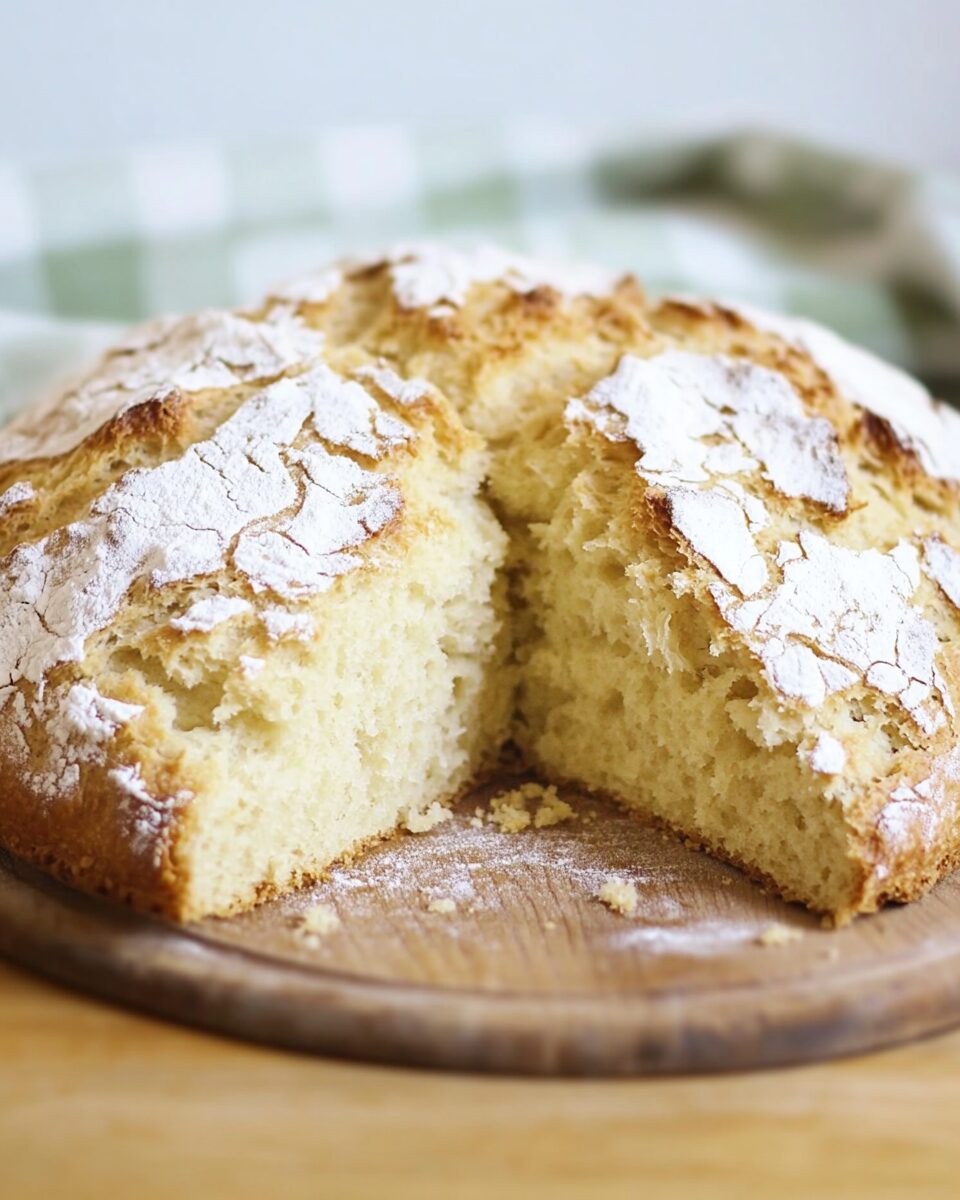Traditional Irish Soda Bread is a humble yet hearty loaf, known for its golden crust and soft, tender interior. With just four simple ingredients—flour, buttermilk, baking soda, and salt—this bread is a true celebration of simplicity and tradition. The signature deep cross cut into the dough before baking isn’t just for looks; it helps the bread bake evenly, creating a beautifully rustic appearance.
Perfect for breakfast, lunch, or alongside a cozy stew, this bread pairs wonderfully with salted butter, jam, or even a drizzle of honey. Whether you’re celebrating St. Patrick’s Day or just want to enjoy a piece of history in your kitchen, this authentic Irish Soda Bread will transport you straight to the rolling green hills of Ireland with every bite.
Full Recipe:
- 4 cups all-purpose or pastry flour (or 3 cups all-purpose + 1 cup whole wheat)
- 1 ¾ cups buttermilk (or milk soured with 2 Tbsp lemon juice or vinegar)
- 1 ½ teaspoons baking soda
- 1 ½ teaspoons salt
- 2 Tbsp sugar (optional, not in the traditional recipe)
Directions:
- Preheat oven to 400°F (200°C). If using a baking stone, place it in the oven to preheat.
- If you don’t have buttermilk, mix 2 tablespoons of vinegar or lemon juice with milk and let it sit for 5 minutes.
- In a large bowl, whisk together flour, baking soda, and salt (and sugar if using).
- Make a well in the center and pour in 1 ¾ cups of buttermilk. Mix gently with a spoon until a sticky dough forms. Add more buttermilk 1 tablespoon at a time if needed.
- Turn the dough onto a floured surface and knead lightly 3-4 times, just enough to bring it together. Over-kneading will make the bread tough.
- Shape into a round loaf and slightly flatten the top. Cut a deep cross (X) on top of the dough.
- Place on a parchment-lined baking sheet, heated baking stone, or in an oiled cast-iron pot or skillet.
- Brush with buttermilk (and melted butter if desired).
- Bake for 45 minutes if making one large loaf or 35 minutes for two smaller loaves. If using a covered pot, bake with the lid on for 30 minutes, then remove for the last 15 minutes.
- Bread is ready when the X in the center looks baked through, and a toothpick inserted comes out clean.
- Remove from the oven, cover with a tea towel, and let cool for at least 10 minutes before slicing.
Prep Time: 10 minutes | Cooking Time: 45 minutes | Total Time: 55 minutes
Kcal: 272 kcal per serving | Servings: 8
The History and Tradition of Irish Soda Bread
Irish Soda Bread is more than just a simple, rustic loaf; it carries a rich history that dates back to the 19th century. While many associate this bread with Irish heritage, the chemical reaction that makes soda bread rise was actually discovered long before in other cultures. Indigenous Americans were known to use pearl ash, an early form of baking soda, to leaven bread. However, it wasn’t until the 1830s that bicarbonate of soda (baking soda) became widely available in Ireland.
Due to the Great Irish Famine and widespread poverty, many Irish families needed an inexpensive, quick, and filling bread that didn’t rely on yeast, which was costly and required special conditions to work. Soda bread became a staple because it only required flour, baking soda, salt, and buttermilk—ingredients that were readily available, especially in rural households where buttermilk was a byproduct of butter-making. This accessibility made soda bread a dietary cornerstone in Ireland, where soft wheat (lower in gluten than hard wheat) was commonly grown and better suited for quick breads than yeast-based loaves.
The Significance of the Cross on Irish Soda Bread
One of the most distinctive features of Irish Soda Bread is the deep cross cut into the dough before baking. While many believe this cross is purely decorative, it actually serves a practical purpose. The cut allows heat to penetrate the thick dough, ensuring that the center bakes properly without becoming too dense or undercooked.
Beyond its baking function, the cross has cultural and superstitious meanings as well. Many Irish households believed that cutting a cross into the bread helped ward off evil spirits and protected the home. In some cases, the cross was seen as a blessing, symbolizing gratitude for the meal and the nourishment it provided. This deep-rooted tradition adds to the charm and mystique of Irish Soda Bread, making it a symbolic food for many families.
Variations of Irish Soda Bread
Although the traditional Irish Soda Bread recipe consists of only four ingredients, many variations have emerged over the years. Some bakers add sugar, raisins, or caraway seeds to create sweeter versions, often referred to as “tea cakes.” Others incorporate whole wheat flour, oats, or even Guinness for a richer, more flavorful loaf.
Another popular variation is “Brown Soda Bread,” which includes whole wheat flour instead of white flour, giving it a denser texture and nuttier flavor. This version is often served with hearty stews or seafood dishes, making it a beloved side for traditional Irish meals.
While these variations are delicious, purists argue that true Irish Soda Bread should remain simple and unadulterated. According to the Society for the Preservation of Irish Soda Bread, anything beyond flour, buttermilk, baking soda, and salt is no longer considered authentic. However, most home bakers enjoy experimenting with different ingredients, creating unique versions that suit their tastes.
Traditional Baking Methods and Tools
Historically, Irish Soda Bread was baked in bastibles—heavy cast-iron pots with lids that were placed directly onto hot coals. This method allowed the bread to bake evenly with heat surrounding it from all sides. The lid of the bastible was often covered with additional hot coals to mimic an oven-like environment, ensuring a well-risen and evenly cooked loaf.
For modern bakers, soda bread can be baked on a preheated baking stone, in a cast-iron skillet, or on a simple baking sheet. Some people prefer to tent the bread with aluminum foil during the first half of baking to replicate the effect of a covered bastible, helping to retain moisture and create a tender interior while achieving a golden, crisp crust.
Pairing and Serving Suggestions
Irish Soda Bread is incredibly versatile and can be enjoyed in various ways. Traditionally, it is served warm with a generous spread of salted butter, which enhances its slightly tangy and nutty flavor. Honey, jam, or even a drizzle of golden syrup can be added for a sweet touch.
For a more savory approach, soda bread pairs beautifully with Irish stews, hearty soups, or smoked salmon. It is also a fantastic accompaniment to a full Irish breakfast, where it can be used to mop up eggs, beans, and bacon. Some people even use soda bread for sandwiches, slicing it thickly and layering it with cheese, meats, or roasted vegetables.
Toasted soda bread is another delightful option, particularly the next day when the bread starts to firm up. A quick toast revives its crispness, making it perfect for dipping into soups or topping with avocado, poached eggs, or ricotta cheese.
How to Store and Keep Soda Bread Fresh
Unlike yeast-based bread, Irish Soda Bread has a shorter shelf life due to its lack of preservatives and fat content. It is best enjoyed fresh on the day it is baked, as it tends to dry out quickly. However, proper storage methods can help extend its freshness.
To keep the bread moist, wrap it tightly in plastic wrap or store it in an airtight container at room temperature. If you plan to eat it within a day or two, keeping it wrapped in a clean tea towel can help maintain its soft texture. For longer storage, Irish Soda Bread can be frozen for up to two months. Simply wrap it in plastic wrap and place it in a resealable freezer bag. When ready to eat, let it thaw at room temperature or warm it in the oven for a few minutes to restore its texture.
Why Irish Soda Bread Remains Popular Today
Despite being a centuries-old recipe, Irish Soda Bread continues to be a favorite among home bakers and food enthusiasts worldwide. Its simplicity, quick preparation time, and rustic appeal make it an ideal bread for beginners and experienced bakers alike. Unlike traditional yeast-based breads, which require hours of proofing and kneading, soda bread comes together in under an hour, making it a convenient choice for those who want homemade bread without the hassle.
Additionally, soda bread is a great example of how necessity and resourcefulness shaped culinary traditions. Its history reflects the resilience of the Irish people, who found ways to create nourishing meals despite economic hardships.
Conclusion
Irish Soda Bread is much more than a quick bread—it is a testament to history, tradition, and the ingenuity of the Irish people. With its humble origins and simple ingredients, this iconic bread remains a beloved staple in kitchens around the world. Whether enjoyed plain, with a pat of butter, or alongside a hearty stew, its comforting texture and rich history make it a timeless classic.
As St. Patrick’s Day approaches, many people turn to Irish Soda Bread as a way to celebrate Irish culture and heritage. However, this delicious bread deserves to be enjoyed year-round. By baking it at home, you not only get to experience its wonderful flavors but also connect with a long-standing tradition that has been passed down for generations.
So, the next time you’re looking for an easy and rewarding baking project, give Irish Soda Bread a try—you may just find yourself coming back to this classic loaf again and again.






